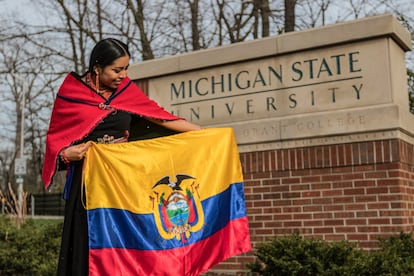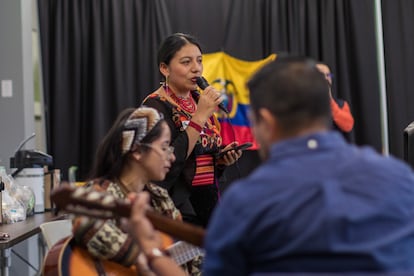–Imanalla, ñukaka Micaelami kani (“How are you? My name is Micaela”), says the teacher at the start of the Kichwa class.
–Ñukaka alli kani, yachachik Micaela (“I’m fine, Miss Micaela”), say the students.
Today’s class is a review lesson in which students will practice what they have learned before a week of exams at Michigan State University (MSU), where these words in Quichua or Kichwa are being spoken thousands of miles from the Andes. For indigenous women like Micaela Jerez Masaquiza and Elsa Caín Yuqilema, teaching their mother tongue so far from their homeland is not simply an educational task, but a way to push back against cultural displacement.

Both women came to East Lansing, Michigan, as Foreign Language Teaching Assistants (FLTAs), to teach Kichwa for a year, as part of an academic exchange through the Fulbright program. They learned the language from their parents and grandparents who spoke it daily in the Ecuadorian Andes where they were born and raised. With its roots in the Inca culture, Kichwa is the northern variant of Quechua, the official language of the Inca more than 500 years ago, before the Spanish showed up. Both women learned Spanish as a second language and used it outside the home. As young adults, Micaela and Elsa also learned English to increase their chances of landing a job.
At Michigan State University, they achieved a greater understanding of their own traditions in order to pass them on and broaden the general population’s knowledge of indigenous peoples in Latin America. “I didn’t really know anything about Ecuador or the Kichwas,” says Julia Tehauno, 23, a student of Micaela’s. “Many people here have an overly romantic idea of what it means to be indigenous. These classes broadened my view of the world.”
Micaela and Elsa have worked alongside the indigenous student organization Timetzalimet, which offered them a safe space within MSU, a mainly white university. Made up of indigenous students from different backgrounds, Timetzalimet allowed them to collectively reflect on the disappearance of indigenous cultures while sharing their own with the rest of the community.

“Students here do want to learn other languages, usually the most popular ones, such as Arabic, Italian, French, Japanese or Spanish. But that doesn’t mean they don’t want to learn indigenous languages. But since there are not many universities or programs that promote them, there are not many options for students to do so,” explains Diana Cisneros, a graduate of Linguistics at MSU.
A taste of the Andes in Michigan
The Inca cross, known as the chakana, has been drawn on the grass with orange, yellow and red petals. Fruits, corn and herbs are also used for decoration. As the sun goes down, Micaela begins a ceremony addressing mother earth and is joined by a yachak or shaman who appears on a computer screen. Micaela translates what the yachak says in Spanish and Kichwa; Dozens of people raise their hands to the sky in gratitude. “Now you know that there is a small Kichwa town called Salasaka in Ecuador,” Micaela says at the end of the event as she holds up the Ecuadorian flag.
Micaela, 29, was born and raised in Salasaka, a small town in the province of Tungurahua. Since arriving at MSU at the end of August 2023, she has introduced Kichwa through classes and events at the university. A few months in, Elsa, 32, a Kichwa Puruhá from Riobamba, in the province of Chimborazo, took over from her.

Further north, Kichwa resists
According to Elsa, the culture is embodied by the language; when a language is lost, so is the culture, and with it, its people. “Kichwa is a vulnerable language, and if it disappears one day, it will be because of us; for not teaching the language to our children or for changing our traditional clothing when we migrate,” she says as she walks around the campus in her Puruhá clothes.
According to UNESCO, in Andean countries such as Peru, Bolivia and Ecuador, where different variants of Quechua are widely spoken, there is a rapid loss of the language, mainly driven by migration and the fact the language is considered secondary to Spanish. Although Kichwa is an official language in Ecuador and the most widely spoken of the indigenous languages, it is fading out. The Ecuadorian government’s 2022 census showed that only 3.9% of the population speak an indigenous language. Of these, 81.7% speak Quichua: 538,449 people, 52,625 fewer than in the 2010 census.

Elsa says that, in some areas, Quichua is no longer part of daily life. You no longer learn from your parents, as Spanish and English dominate the linguistic landscape. Young people often neither speak Kichwa nor wear traditional clothing. For many, not speaking Spanish “well” has exposed them to derision. “People should understand that Kichwa is our mother tongue and Spanish is our second language, and we are looking for a balance,” says Elsa. “It is normal that our Spanish is not perfect, but we are still criticized by Spanish speakers.”
Elsa and Micaela’s work as Kichwa teachers at an American university demonstrates that teaching an indigenous language can be a profoundly significant act of resistance. In Latin America, where indigenous languages are disappearing at an alarming rate, teaching a language heading for extinction becomes an act of cultural affirmation, memory, and hope. “Although I am far from my people in this foreign country, I resist,” Micaela says.
Sign up for our weekly newsletter to get more English-language news coverage from EL PAÍS USA Edition






